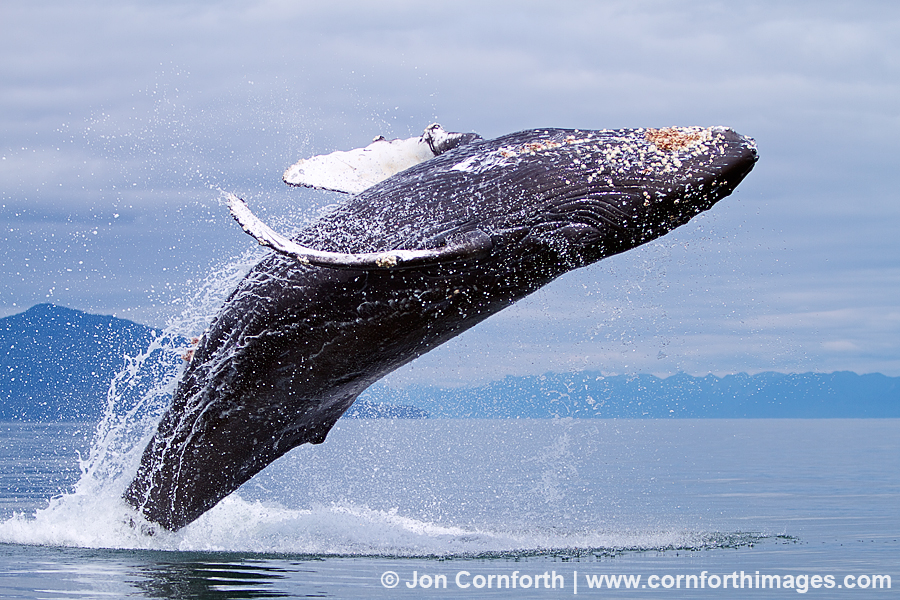
Humpback Whale Photography Tour
Posted onI’m teaming up with renowned underwater photographer Tony Wu to offer the ULTIMATE humpback whale photography adventure in 2012. The first half of our tour will begin in Southeast Alaska, where I have spent 5 years photographing humpback whales, followed by a two week break, and then finishing in the Kingdom of Tonga, where Tony has spent over 10 years photographing humpbacks. This is a unique, immersive experience to witness and photograph a wide range of humpback whale behaviors in two hemispheres.
Starting in Juneau, Alaska, we will use our expedition yacht and inflatable boats to photograph northern hemisphere humpback whales bubble-net feeding, breaching, and other behaviors. After our short break, we will regroup in Tonga for in-water encounters with southern hemisphere humpbacks where we’ll be looking for mothers with babies, singers, heat runs, mating, and other calving-related activities. Seeing the whales with your own eyes beats watching a TV documentary!
This trip is for a small, exclusive group of 6 guests who will be able to travel to both locations with guides Jon Cornforth and Tony Wu to photograph a wide range of humpback whale behaviors. Our core idea is to share a once-in-a-lifetime experience with the same 6 guests in order to provide the most comprehensive humpback whale photography opportunities. If someone is interested in only one part of this combined trip, we will automatically put them on our waitlist, but we will only fill single slots after we have prioritized spaces for guests interested in both trips.
For more information, please visit my Humpback Whale Photography Tour page.

Humpback Whales Bubble Feeding 132
Posted onPhotographing humpback whales bubble-net feeding in Southeast Alaska is the most incredible experience that I have. Over several days in July, I was again fortunate to witness this extraordinary behavior. Even though I cruise with my own boat, finding a groups of whales feeding can be difficult and time consuming. However, once I have located them I drift nearby for hours hoping that they will occasionally come close enough to be photographed. During their attack the whales emit a high-pitched song to scare the fish and coordinate their timing. (Check out my YouTube video to hear what it sounds like.) To create a picture like this, my reflexes have to be lightning fast. It certainly helps if my camera is already pointed in the right direction when they break the surface. The momentary drama of water exploding into the air and fish jumping out of the whale’s wide-open mouths to avoid being swallowed is beyond my wildest dreams. I used my Canon 7D and 70-200mm f2.8 IS lens at 70mm to create this image.
Humpback Whale Breach 117
Posted on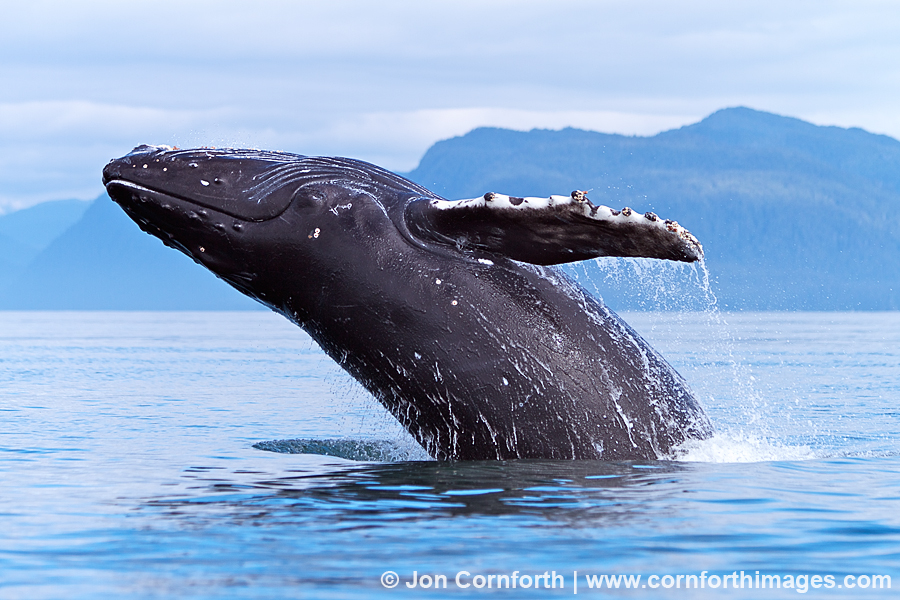
Here is another amazing humpback whale breach that I photographed during my July trip in Southeast Alaska. Breaching whale encounters never get old. I wish that I could photograph whales every day, but for a variety of reasons it would be impractical, least of which is that they don’t cooperate like this very often. This juvenile humpback probably breached close to 100 times over the 2+ hours that I spent photographing it. This gave me ample time to maneuver my inflatable into position with the sunlight at the best angle and with the most pleasing mountains in the background. I did not anticipate where the whale was going to breach correctly every time, but when I did, I was rewarded with images like this one. The hardest part of photographing breaches is having my camera pointed in the right direction and responding fast enough before the entire moment is over. I used my Canon 7D and 70-200mm f2.8 IS lens with a shutter speed of 1/1300 second to stop the action.
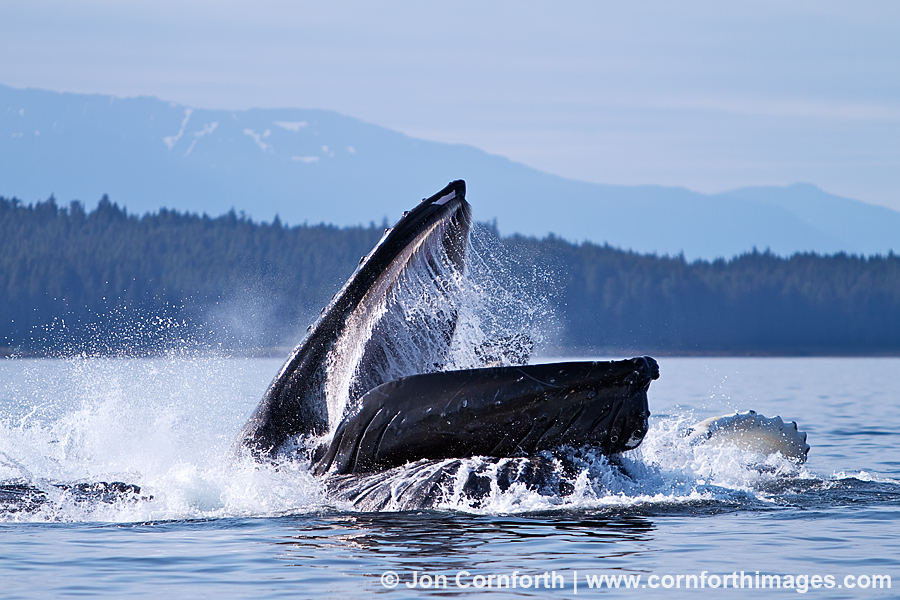
Humpback Whales Bubble Feeding 100
Posted onI always say that if I could photograph only one thing, that it would be whales. Unfortunately, they are the most difficult and expensive subject that I photograph. I have swam next to these gentle giants and watched them repeatedly breach into the air, but the most amazing behavior I have documented is humpback whales bubble-net feeding in Alaska. This phenomenon involves a group of whales diving beneath a school of fish and blowing a ring of bubbles underwater to effectively form a net as it rises to the surface. The ring can be up to 100′ in diameter. The fish get scared by the bubbles and become concentrated in the center. At the last second the whales swim up from beneath the school of fish with their months open swallowing everything they can in one enormous gulp. Research has shown that the individual whales repeatedly take up the same positions as they come out of the water during each attack. The best photographs include the most dominant whales in the center positions as they burst above the surface and slam their mouths closed. An incredible amount of patience and luck is involved in anticipating where the whales are going to form a bubble-net. If I am close enough and can see the bubbles rising at the last second, I have to react fast enough to capture the moment as they lunge out of the water. Magnificent!

Humpback Whale Tail 101
Posted onFor marine mammal photographers like myself, photographing whale tails is not that hard to do, but creating a striking image is. This is the only part of the animal that most whale watchers will ever see. It’s not the most dramatic behavior, and certainly nowhere near as photogenic as a full body breach. Over the years, I have taken tens of thousands of whale tail images. I am grateful that I no longer have to spend money on film since most of these images are utterly useless and unworthy of even the 1 second of my time that it takes for me to hit the delete button. Still, every once in a while I photograph a nice tail, like this one. Here’s how the sequence of events needs to work in order to create an image like this. A whale has to surface within a few hundred yards of my boat. It will normally take 3-5 breaths on the surface before diving, which might give me enough time to close the distance on the tail and take up a position behind the whale, not slightly to the left or right, but directly behind it. When the whale begins its dive, there is usually 1 image where the tail is almost at its apex and water is pouring off of it. I am also ever vigilant for a pleasing background, like these snow capped peaks and non-distracting blue mountains in the distance. The entire image has to come together, not just any one part. You can also see other whale photos when you visit my whale photo galleries.
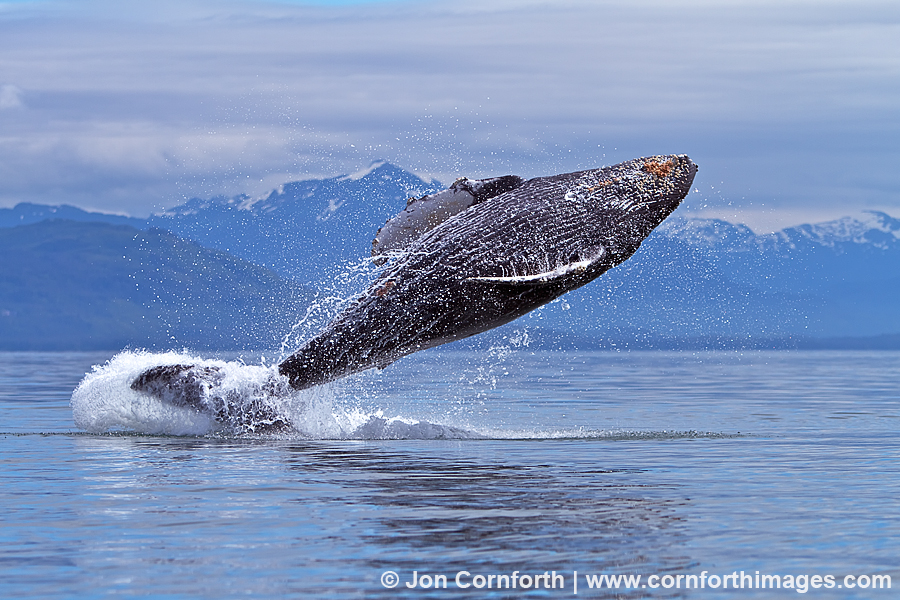
Humpback Whale Breach 108
Posted onAnother freakin’ humpback whale breaching photo? Well, yes, it is! I normally prefer breaching images at the peak of the whale’s trajectory, because they don’t appear as powerful in the limp-coming back down phase, let alone when the big splash happens. However, what I do like about this image is that it shows the power of the whale’s tail propelling it almost completely out of the water. You can see that there is very little of the whale still connected to the surface. I had to keep moving my inflatable for safety, but I also wanted to keep the whale on the inside of me in order to photograph it against the pretty blue mountains in the distance. See more photos of humpback whales.

Humpback Whale Breach 106
Posted onAs I have previously mentioned, I will be editing my new humpback whale breaching images for months to come. This is another graceful breach from the incredibly cooperative whale that I photographed last month in Frederick Sound. This young whale repeatedly displayed its enthusiasm for the warm sun, good eating, close friends, and nearby photographer for almost 2 hours. I could not capture every breach perfectly, but I am pleased with how many of the sequences yielded surprising images. Take this one for instance. It is not the boldest breach ever, but I like the gentle angle, perfect composition, and delicate twist of water emanating from its pectoral fin. It just looks like a happy whale.

Humpback Whale Breach 105
Posted onAfter departing Juneau and motoring down Stephens Passage to Frederick Sound, I spent my first night anchored at the Brothers Islands. Because of the long distance I’d motored the day before, my first priority was refueling. En route to the Kake fuel dock, I encountered my first breaching humpback whale! This whale was clearly happy that I was there to photograph it and could not contain its enthusiasm for my arrival. I normally use my more maneuverable inflatable to photograph breaching, but since I was on my C-Dory, I quickly passed the helm off to my dad as I grabbed my camera and headed towards the bow. The whale was heading in my direction and posed several times for me where I told it to. Thank you for your cooperation whale and see you in Hawaii next winter.

Humpback Whale Breach 103
Posted onI hope that my regular readers aren’t getting bored yet of all my new breaching humpback whale photos. Though I had spent over 20 weeks the last 4 summers cruising Southeast Alaska with my boat, not until 2 weeks ago did I encounter a whale that yielded so many publishable breaching images. I could post a unique breach a day for the next month if I wanted to. What an amazing experience! Based on my hectic travel schedule, I will still be editing and posting these images well into the fall.
I have high standards for photographing whales, especially since I am friends with some of the top professional marine photographers in the world, like Doug Perrine, Brandon Cole, and Stuart Westmorland. I prefer to use my Canon 70-200mm f2.8 IS lens to photograph breaching. This lens gives me the flexibility to zoom in and frame the breach once I see it start to happen, but requires me to be relatively close to my subject. I used to also use a Canon 1.4X tele-converter, but now prefer the results of using the smaller image sensor on my Canon 7D with its 1.6X crop. I am a real stickler when it comes to my photography ethics and consider cropping more than 10% of the original image a failure. At 8fps, I typically capture a number of out of focus, poorly composed images, with a horizon that is consistently skewed down to the right. Thus, I am particularly pleased when I capture a moment like this, especially at 70mm.
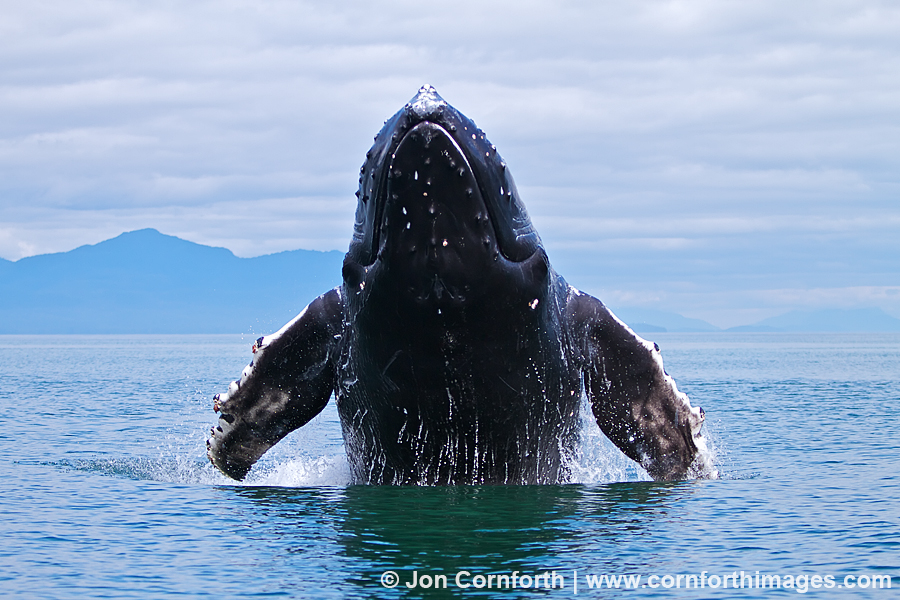
Humpback Whale Breach 101
Posted onTwo weeks ago, I photographed this humpback whale on Frederick Sound. I find this image particularly striking due to the unusual, head-on perspective. The humpback breached towards me which helped illustrate its streamlined body. Also, the pectoral fins in this shot are perfectly angled at the whale’s side as it thrusts itself out of the water. This young whale must have breached at least 50 times over a 2 hour period. Incredible! I was able to anticipate the breaches about 50% of the time and zeroed in on about 12 different sequences that will yield publishable humpback whale images. My dad was with me and managed to capture this breach on video using my iPhone, which you can view on YouTube.
